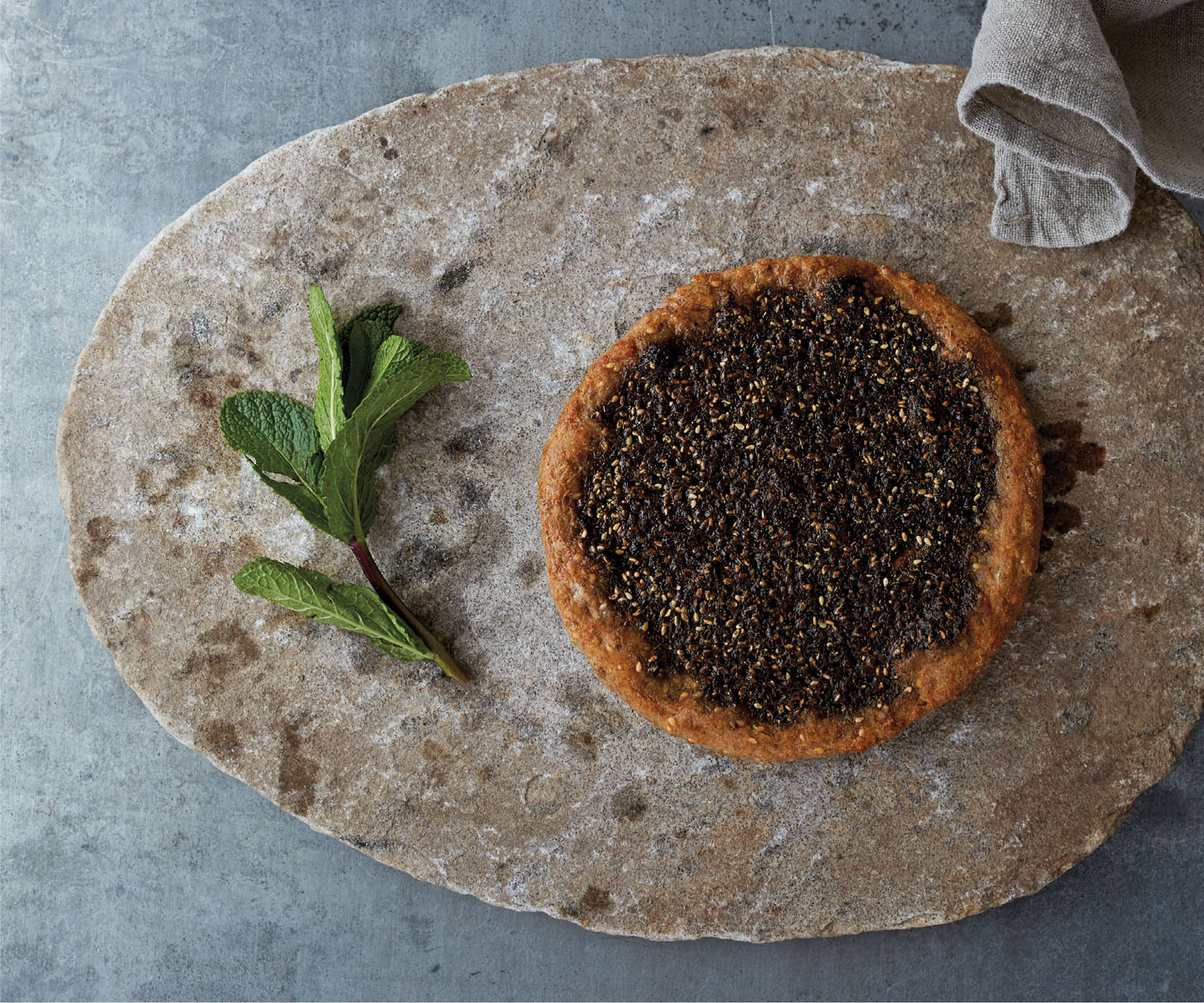Southern Lebanese Za’atar “Pizza”
MANAQISH JREESH
LEBANON

Manaqish are the quintessential Lebanese breakfast, a sort of Lebanese “pizza” that comes with a variety of toppings. The most common topping is a mixture of za’atar (a dried herb mixture) and olive oil, and you can have these za’atar manaqish either plain or wrap them around labneh, fresh mint, olives, and tomatoes. In southern Lebanon, which is mostly Shi‘ite, manaqish are often made with the same dough as that for mishtah, a regional flatbread that is made with added cracked wheat and is seasoned with a mixture of spices, which gives it an intriguing flavor and texture. I had never tasted mishtah or even knew about it when I lived in Lebanon, which is strange given how small the country is. But despite its size, Lebanon has distinctive and often hidden regional specialties; and now that I have discovered mishtah, thanks to my friend Nayla Audi whose family comes from the south, it has become my favorite Lebanese bread and I often use mishtah rather than pita dough to make my manaqish. You can use either. The recipe below was given to me by a baker in South Lebanon who makes his mishtah in individual round loaves—other bakers make them very long, a little like Roman pizza, which they then cut and sell by the slice. You can replace the za’atar with thin slices of Halloumi cheese or even lay the sliced Halloumi over the za’atar (about 6 thin slices of cheese for each round of dough); it is a good idea to rinse the cheese to make it less salty.
MAKES 6 INDIVIDUAL “PIZZAS”
FOR THE DOUGH
3⅓ cups (375 g) whole wheat flour, plus all-purpose flour for kneading and shaping
1 packet (7g/2¼ teaspoons) instant (fast-acting) yeast
1 teaspoon fine sea salt
3 tablespoons sesame seeds
3 tablespoons anise seeds
½ teaspoon ground mahlep
½ teaspoon ground anise seeds
½ teaspoon daqqat kaak (a special spice mixture from the south; optional)
¾ cup (125 g) King Arthur’s organic cracked wheat (jreesh), soaked for 1 hour in cold water, drained
Extra-virgin olive oil, for the bowl
FOR THE TOPPING
6 tablespoons za’atar
½ cup (125 ml) extra-virgin olive oil
1. To make the dough: Mix the flour, yeast, salt, sesame seeds, and spices in a large bowl. Stir in the cracked wheat and make a well in the center. Gradually add 1¼ cups (310 ml) warm water, bringing in the flour as you go along. Mix until you have a rough ball of dough.
2. Transfer the dough to a lightly floured work surface and knead for 3 minutes. Shape into a ball, invert the bowl over the dough, and let rest for 15 minutes. Knead for 3 more minutes, or until the dough is smooth and elastic. Grease a large bowl with a little olive oil. Shape the dough into a ball and place in the bowl, turning it to coat all over with oil. Cover with plastic wrap. Let rise in a warm, draft-free for 1 hour, until more or less doubled in size.
3. Transfer the dough to your work surface. Divide into 6 equal portions. Shape each into a ball. Cover with a very damp kitchen towel. Return to rise for 45 minutes.
4. Flatten each ball with your hands or a rolling pin into a round 7 to 8 inches (17.5 to 20 cm) in diameter. Transfer to a nonstick baking sheet (or a regular baking sheet lined with parchment paper or a silicone baking mat).
5. To make the topping: Mix the za’atar and olive oil in a bowl. Dividing evenly, spread the za’atar mixture on the dough rounds, making sure you oil the edges. Let rest for 10 to 15 minutes.
6. Preheat the oven to 500°F (260°C) degrees, or to its highest setting.
7. Bake for 10 to 12 minutes, or until lightly golden. Serve warm or let cool on a wire rack to serve at room temperature.